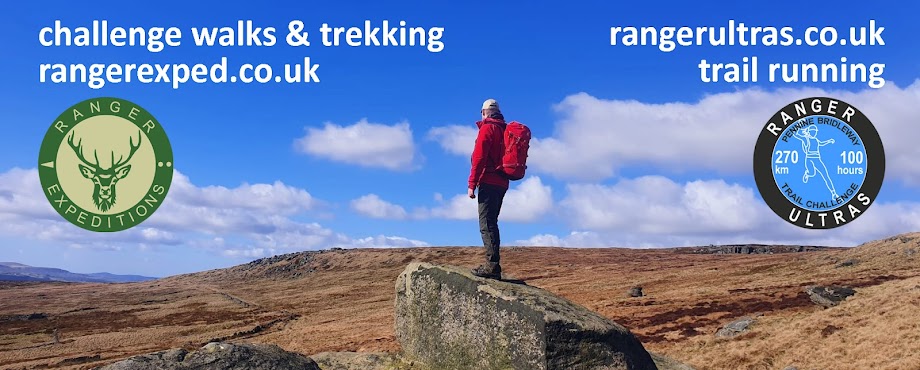Starting in Hayfield, my route ascended steadily for 30 minutes up the Pennine Bridleway to South Head.
The hill had sheltered me from the southerly wind, but once jogging along to Rushup Edge, the forecast for heavy showers proved accurate and I paused to put on my jacket.
Warm summer humidity returned after the shower, so jacket off and over the habitat conserving slabs to the Brown Knoll 569m trig point.
But not 5 minutes later and dark clouds rolled in from the valley and another heavier shower arrived. This was the established pattern for the day. I pressed on to the saddle at the top of Jacob's Ladder.
Visibility was down to 30 metres on Kinder, but I knew the route off by heart having walked and guided up there for several years. I paused in the lee of a rock near the 633m Trig Point for a snack. A few folks in passing by were quizzically looking at mobile phone apps.
Frustratingly, my own phone touch screen didn't want to cooperate with my video plans to do a short piece to camera about the successes of Tusk Trust over the past 30 years and the challenges currently faced by Lewa Wildlife Conservancy due to Covid-19.
Perhaps with a little imagination the hills in the mist could be taken for the foothills of Mount Kenya...or maybe not.
At the time, the Lewa Safaricom Marathon was the only marathon held inside a game reserve. Mount Kenya is a magnificent presence on the skyline, at daybreak its steep slopes glow orange and pink. Early morning is a joy in Kenya. For the first half marathon circuit running was free and easy. But while the elites were finishing their 42.2km, for everyone else on the full marathon the African sun burned like a torch, stealing the oxygen from every breath.
My finishing time of 4h 18min was a footnote compared to the inspirational local professionals but it was good enough to be the 7th fastest non-Kenyan
Onwards, following the Pennine Way northwards. Another persistent shower but the gritstone felt sure underfoot. Past the blown back spray from Kinder Downfall. The weather had kept most of the usual Saturday walkers at home. I was grateful for unimpeded progress as the rain intensified into a deluge and wind picked up.
But this was no time to slacken off and get cold. Just another ten minutes to the top of Sandy Heys and then a careful descent over saturated slopes and through run off water, to Kinder Reservoir.
No defassa waterbuck or sitatunga here, but I did catch a glimpse of a lovely roe deer in red summer coat.
Then it was a bob back into Hayfield and home well before the afternoons thunderstorm forecast.
Over the past 30 years Tusk Trust and Lewa Conservancy have set the gold standard in partnering wildlife conservation with communities and education. Millions of hectares have been secured for wildlife, with investment in jobs and training for local people to protect inconic species such as rhino, elephant, lion, cheetah, African wild dog, gorilla and chimpanzee.
Everyone is affected by Covid, but wildlife especially so, with complete loss of tourism revenues in Africa. This is impacting on Ranger anti-poaching and security operations as well as conservation projects.
I'm proud to support Tusk Trust so that future generations can experience the sight of elephant in the shimmering heat and the roar of lions in the night.
I've made a donation through Tusk Trust for this virtual run, but with so many friends struggling at the moment, I've not set up a just giving page or such like. It just didn't feel right to do so. But if you would like to support Lewa and Tusk conservation projects, I've included a link here...
https://www.tusk.org/donate/
Thank you & safari njema
Stu
#TuskLewaSafariChallenge #LewaSafariMarathon #RunWildKenya



















